The perfect Christmas gifts of 2021

With Christmas only around the corner, now is the perfect time to get your Christmas gifts chosen and beat the last-minute rush. To help take away some of the stress, Ucan2 has done the hard part for you and tracked down the 6 perfect gifts for your nearest and dearest. The top 6 Christmas gifts 1 The Henry Bell Sterling Feeding Station (RRP £19.99) Beautifully made and finished in sparkling silver. This premium product is designed to enable and enhance wild birds wellbeing as well as bring a stylish, and festive statement piece to the garden. The perfect gift for anyone with a love for nature and watching the birds feeding. It’s available to purchase at your local Dobbies Garden Centres but if you prefer to order online you can do so here via www.food4wildbirds.co.uk. 2. Novantaceppi Italian wine (£12.00) An all-Italian line of wines, the result of a collaborative project between oenologists; ninety is the number of plants that were initially selected for the start-up of this wonderful oenological project. Perfect for gifting: Novantaceppi Primitivo Indicazione Geografica Protetta (IGT) Puglia is one of the most famous & popular wine brands in Europe. The wines’ exceptional taste & elegant bottle design come with an accessible price tag of £12.00 (Amazon). A stylish Christmas gift for wine lovers or connoisseurs. You can order them on Amazon here. 3. Wellbeing Sisters – Discovery Box (£30) Wellbeing Sisters; a clean beauty and lifestyle subscription box brand. The Discovery Box is very much for those that are looking to make a more conscious choice in their purchasing or perhaps want to start swapping their current product choices for a cleaner version. All the products selected will help you to ditch those everyday products that could be interfering with your health and wellbeing, and replace them with toxin-free ones, to help you start your journey towards healthier living. The perfect subscription gift for anyone who wants to make cleaner choices in the beauty regime. You can subscribe here. 4. Modern-day Pill Case – Tabuu ( £18.00) Tabuu’s pill case is stylish, tactile, and able to hold up to 6 large tablets. At 7.5cm, a case can fit in a bag, on a keyring, or in your pocket to keep your medication safe whilst you’re on the go. A modern-day pill case to carry your medication in! The stylish and waterproof pill case is for people who don’t want their medication to define their lifestyle. It’s available to purchase here. 5. U-Shaped Support Pillow (£54.99) The ergonomically designed U-Shaped Support Pillow is a versatile product that can be used for sleep support, to prop users up in bed or on the sofa (whilst watching TV, using a tablet, laptop or mobile device), to separate legs and keep hips aligned and to stop cold draughts to the back in the winter. The Arthr U-Shaped Support Pillow can be used as a standard pillow as well as a spooning pillow, due to the added benefit of its dual side supports. It comes with a zipped, washable, removable, super-soft, velour cover and has a 2-year guarantee. The perfect Christmas gift for anyone who suffers from arthritis. It’s available to purchase here. 6. RiSE Coffee Box (£19.99) A coffee subscription box with various options to suit everyone’s needs including fortnightly, monthly, bi-monthly or a one off trial option. Featuring handpicked, premium coffee from independent roasting partners, a little treat, carefully curated and chosen for you from one of our sustainable tasty friends (previous partners include: Tonys Chocolney, Mr. Black Spirits, Brave Foods & The Protein Ball Co.) plus recipes and more. RiSE Coffee Box will deliver a new and unique coffee box straight to your door every month for £19.99 (one-off gifting boxes also available). So there you have it, our Christmas gifts round-up for 2021. We’d love to hear all about what you choose. Let us know which is your favourite over on social media.
Support As Individual As You Are – Introducing the Leckey BeMe
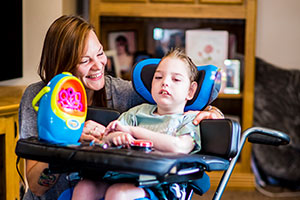
Leckey is delighted to announce the launch of BeMe, a ground-breaking, infinitely configurable seating system that provides the highest level of individualised support for children. Designed with the needs of the child as the primary focus, BeMe provides superior support for posture, comfort and function through its interchangeability and configurability. Suitable for children with mild to complex postural needs, this seating system features a universal component known as the core, from which other parts can be quickly and easily attached and detached. It comes in three sizes, and offers three seat options, three back supports, high-low chassis, manual and power Sunrise Medical wheelchair bases, as well as interchangeable accessories in a range of sizes and complexities, making it easy to find the right support. One of the most exciting innovations that BeMe has to offer is the world’s first truly growable contoured cushion. Whilst the benefits of contoured seating have long been recognised in wheelchair design, BeMe’s contoured seat has taken these design principles a step further, using a high-stretch fabric and expandable foam to maximise pelvic stability and comfort as the child grows and develops. This breakthrough in support technology envelopes the child, increasing pressure distribution and reducing the need for additional accessories such as pommels and hip guides. BeMe will initially launch in the UK and Ireland, with further launches scheduled in early 2022 in international markets. Ben Stocks, Managing Director at Leckey commented, “We are incredibly excited to launch BeMe, a product that will revolutionise seating and help transform the lives of many children and their families. This product is the culmination of many years of research and development where we have listened to therapists, carers and parents about the challenges they face with traditional seating systems and we have responded. BeMe is truly ground-breaking and spec’d to perfection, offering a whole new level of configurability and personalization, to achieve our overriding goal of fitting the chair to the child, rather than the child to the chair.” Clinical Director for Leckey, Dr Laura Finney, added, “BeMe was designed to deliver the best in posture, function and comfort, through its unique modularity and smart innovation that caters to a wide range of children, of differing age, ability or need. We have conducted long-term BeMe evaluations and were so encouraged to see children who have previously been unable to tolerate other seating systems significantly benefit from BeMe. BeMe has not only enabled children to achieve an excellent supported and comfortable seating position, but has made them more confident and independent in their daily activities, empowering a child to simply BeMe.” To find out more, please visit https://www.leckey.com/products/beme-seat . For additional information, please contact orla.leonard@leckey.com
Hate crime training for Avon and Somerset Police
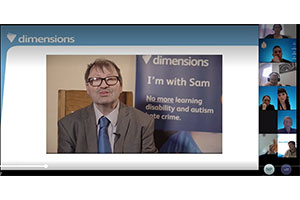
Dimensions, the UK’s largest not-for-profit provider of support for people with learning disabilities, autism and complex needs, and Discovery, the ground-breaking partnership between Dimensions and Somerset County Council, has led a disability hate crime training and awareness session for Avon and Somerset Police to mark National Hate Crime Awareness Week. Disability hate crime is a prevalent issue across the country. Between 2019 and 2020, online disability hate crime rose by 50% while 2020/21 figures show that 9,252 disability hate crimes have been reported across England and Wales, equivalent to 25 per day. A disability hate crime can range from name calling and theft to physical abuse and threats. It is important to note that, according to Dimensions’ 2021 hate crime survey, 71% of perpetrators and 33% of victims with learning disabilities and/or autism were adults, highlighting that disability hate crime is not just playground bullying and has serious consequences. Indeed, 35% of respondents with learning disabilities and/or autism who had been victims of hate crime are now more afraid of people as a result of their experiences. Launched to mark Hate Crime Awareness Week, Dimensions’ 2021 research found that just 31% of people with learning disabilities and/or autism reported the most recent time they experienced hate crime to the police. For disabled individuals more generally, 41% were ‘very unhappy’ with the police’s response. Concerningly, 8% of those with learning disabilities and/or autism did not report it at all. Amongst those who did not report the crime, 67% said this was because they did not think it was important enough, while 33% did not feel the police would listen. Dr Mark Brookes MBE, Advocacy Lead at Dimensions and expert by experience, led the training for Avon and Somerset Police, empowering frontline officers to make reasonable adjustments for people with learning disabilities and autism across Avon and Somerset. Adjustments include building links with those who are at risk of disability hate crime within the area and providing clarity at every stage of the reporting process, ensuring individuals feel more confident when speaking to the police and, as a result, increasing the likelihood they would report a crime. By making these adjustments, frontline police officers can help tackle the low rates of disability hate crime reporting currently experienced both in the Somerset area and nationally. Dimensions has also worked with the National Police Chief’s Council to create a guide on identifying and reporting disability hate crime and offers training to police forces across the UK. This includes a recent seven-month programme for Surrey Police, following which 90% of officers said they felt more confident taking a report from someone with a learning disability. Reporting rates for disability hate crime in the area also increased following the training programme. Dr Mark Brookes MBE, Advocacy Lead at Dimensions, said: “As someone with a learning disability, I’m very proud to be part of this training. We are now celebrating five years of Dimensions’ #ImWithSam campaign to tackle disability hate crime, but many people still don’t know what a disability hate crime is or have the confidence to report it. Raising awareness and ensuring that frontline police understand about making adjustments is essential if people are going to feel confident reporting a crime.” Helen Orford, Managing Director of Discovery, said: “Discovery and Dimensions are incredibly proud to deliver this disability hate crime training for Avon and Somerset Police, especially during National Hate Crime Awareness Week. The statistics from our 2021 hate crime survey speak volumes to the importance of this training initiative, alongside our 2016 findings that almost half of police officers in the UK (46%) had never received any training around learning disabilities and/ or autism. “Discovery aims to make life better for everyone with a learning disability and/or autism across Somerset. Ensuring that our local police force is equipped and empowered with the tools to make adjustments for victims of disability hate crime, build relationships and increase rates of reporting is crucial to achieving this. We would encourage other Somerset public services to get in touch and join the effort to raise awareness of learning disability hate crime through this training.” Superintendent Wigginton and Inspector O’Mahony, of Avon and Somerset Constabulary, said: “Avon and Somerset Constabulary would like to extend heartfelt thanks to Dr Brookes and the Dimensions Team for the brilliant input they provided to police officers and staff at the Hate Crime TAC training day on 14/10/2021, as part of National Hate Crime Awareness Week. The session provided our teams with invaluable insight, and the ‘I’m With Sam’ campaign video is something we’ll be sharing across the Constabulary. The session was informative and moving, and really re-iterated the devastating impact that Hate Crime can have on individuals and communities. We are absolutely delighted to be working with Dimensions around this incredibly important issue, and look forward working collaboratively with them in the future.”
ADHD in girls – how misconceptions impede diagnose
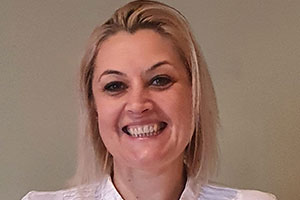
Louise Karwowski, Director of Education at Cognassist talks to Ucan2 about ADHD in girls for ADHD month. Attention deficit hyperactivity disorder, or ADHD, is a condition that comes with stereotypes – fidgeting and a general struggle with self-control. However, as with most neuropsychiatric conditions, our assumption that they are single faceted or are exhibited in a group of neatly defined behaviours is misguided. For a condition that affects approximately 5% of children and 2% of adults in the UK, too few people recognise that ADHD comes in numerous forms, with girls often exhibiting symptoms that are different to those most often associated with the condition. For this reason, diagnoses occur three times more often in boys than in girls, with boys receiving more frequent referrals to mental health professionals. Failure to identify and diagnose young women and girls with ADHD can have long-lasting and serious effects on their rest of their lives – research has shown a lack diagnosis, and therefore a subsequent lack of support, can affect an individual’s work performance, mental health and relationships throughout their life. It is therefore of the utmost importance that we bridge this knowledge gap and ensure girls with ADHD are no longer left behind. Understanding the subtypes of ADHD There are three subtypes of ADHD – hyperactive-impulsive, inattentive, and combined, each of which has slightly different symptoms. These variations can make diagnosis trickier as people’s understanding of the condition may not align with the behaviours exhibited. Those with the hyperactive-impulsive subtype are most likely to fit the stereotype of ADHD mentioned above – fidgeting, impulsiveness and excessive restlessness. Those with the inattentive subtype are less likely to struggle with self-control or have difficulty sitting still, but rather are more prone to making careless mistakes and struggle with concentration and organisation. As girls tend to present with the inattentive type, there can be a delay in diagnosis as they are thought to be shy, withdrawn or passive rather than potentially having ADHD. Usually, they do not get a diagnosis, or their symptoms are mistaken for depression or anxiety. The problem is made worse by the fact that the bulk of ADHD research has been conducted on boys and men. Generally speaking, boys will show symptoms very early in life, and see a decrease in symptoms at puberty. The opposite is true for girls, whose symptoms may be exacerbated by increasing levels of oestrogen during puberty. This means they are less likely to meet the classic diagnostic criteria and may slip through the net. Spotting the signs Moving beyond the narrow understanding of ADHD most people have is, of course, the first step in addressing failures in diagnosing young girls and women with the condition. Once we have done so, the identification and diagnosis of symptoms is likely to improve. Some symptoms friends and family can look out for that tend to manifest in girls include a lack of attention to detail, becoming easily distracted, trouble focusing, or becoming bored quickly. Those with ADHD can often have difficulty learning or organising new information, trouble completing homework or losing items needed to stay on task. Daydreaming and confusion can be common, as well as seeming not to listen when spoken to. They might find it difficult to follow instructions or generally process information more slowly, which means mistakes can be more frequent than peers. As such, most of the symptoms of ADHD are actually issues with executive function. These symptoms change over time, so children may fit different presentations as they get older. This, again, is something that must be appreciated to address the lack of diagnoses for women and girls. What parents can do Many parents will also wonder what they can do if they suspect their daughter may have symptoms of ADHD. When a child is very young – until the age of around three – it can be difficult to identify cognitive issues. Obviously, parents will want to ensure that their child is building a secure foundation for learning and processing information, but it’s important not to jump to conclusions if you think their progress is a little slower in these areas. In this age range, what’s normal in terms of neurological development varies widely and many ‘late developers’ will catch up. When a child is a few years older, if you suspect they may have a learning need, it’s a good idea to have them tested for a condition and potentially have a diagnosis confirmed. A diagnosis can open the door for your child to receive appropriate learning support in school, so it’s worth looking into this as early as possible. Acknowledging difference in a positive way and framing this in terms of strengths and weaknesses can be helpful, especially if a child is feeling sensitive about needing support. If they do receive a diagnosis of ADHD, it is important to remember that medication is not the only answer. A comprehensive multimodal approach to treatment that includes behavioural, psychological, and of course -considering the current systemic failings – educational support is required. Put together, these pillars of support will help to address areas where they may struggle, while encouraging their strengths to develop even further. Diversity within human thinking should be celebrated. There’s no such thing as a ‘perfectly normal’ brain: in fact, our brains are all unique, just like our fingerprints but far more complex. What’s crucial is that everyone’s strengths and weaknesses are fully supported, so that they are able to flourish and reach their full potential. Openness, acknowledgement of difference and receiving the right support can be transformational for young girls, helping to remove any barriers they face in their education and throughout their lives. Read our article on the top activities for children with ADHD: https://www.ucan2magazine.co.uk/blog/adhd
How Geberit is improving the wellbeing with bathroom solutions
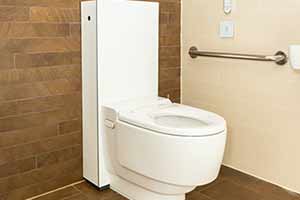
Wellbeing has become a popular buzzword referenced frequently in daily life, but what is the true meaning of the word? The Care Act of 2014 defines wellbeing as relating to, amongst other things, personal dignity, mental health and control by an individual over their own day to day life. For a huge number of people across the UK, the reality is that an everyday task such as using the toilet can be a task they’re unable to do alone and with dignity, and this can have a significantly detrimental impact on their overall wellbeing. It can be difficult to provide this independence, especially in the bathroom, however, the bathroom can also be the room that, when adapted correctly, can make the biggest difference. Installing the right equipment makes life easier and supports wellbeing. Adaptions like these are not uncommon, as a quarter of households that require general adaptations require an adaptation to the toilet. Shower toilets, for example, are often referred to as a lifeline, as an individual with a shower toilet installed can live at home with minimal additional support. That’s why manufacturers like Geberit support users, carers and families with continued innovation to offer bathroom solutions for all age groups and needs. The Geberit AquaClean Mera Care Shower Toilet offers both dignity and independence in the bathroom, reducing anxiety and increasing confidence, as using the toilet becomes easier. National Sales Manager for Geberit, Simon Thomas believes that “while there is no magic wand to provide additional funding or reduce red tape in this area, with greater education, enhanced visibility of key solutions and a more collaborate approach, I believe it is possible to close the gaps between identifying a need and installing solutions that can have a huge and lasting impact on wellbeing whilst creating greater independence for individuals. We developed every aspect of the Geberit AquaClean Mera Care with this goal in mind and the aim of combining the newest technology with beautiful aesthetics to deliver a product that really could make a difference.” However, we are all different and something that acts as a solution to one person might be a challenge to another. That’s why the Mera Care is designed with personalisation at its heart. While the Mera Care comes as a standard package with everything included, every detail can be customised to ensure individual needs are met. For example, the position of the spray arm and the intensity and temperature of the spray can all be adapted, as can the warm air dryer. The Mera Care is flexible to accommodate specific height requirements at installation thanks to the inbuilt adjustable stainless-steel frame and can be used in conjunction with a range of shower chairs, benches and wall mounted grab rails. Being in control is also key to feeling confident and that’s why the Mera Care can be operated via the touchless wall panel, handheld remote, app or even voice control. This means that no matter the situation you can feel confident and independent. All these elements work together to create an adaptation that not only increases independence in the bathroom but can also have an unprecedented impact on wellbeing. Alison Rowe, who had a Geberit AquaClean Mera Care installed in her home in early 2021 said about the adaptation ‘I can’t believe how much the AquaClean has revolutionised my day-to-day life. I was always worried, self-conscious and anxious before but now I have the AquaClean installed I don’t have to worry anymore.’ To find out more about how the Geberit AquaClean Mera Care can work for you visit www.geberit-aquaclean.co.uk/care
Janice Sylvia Brook reveals how a childhood fraught with pain drove her to success
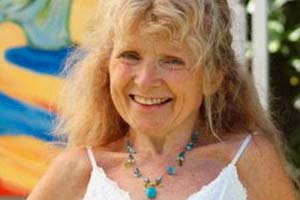
Ucan2 speaks with the artist Janice Sylvia Brook, on how she has overcome her disability to have paintings hanging in the Whitehouse. Janice Sylvia Brock’s talent has brought her a life beyond her wildest dreams, even though she needs two hands to hold a paintbrush. Janice Sylvia Brock is an internationally acclaimed artist whose work hangs in private collections in Europe, the Caribbean, South Africa, Australia, New Zealand, Japan and in Canada and the USA where two small oil paintings depicting the English landscape grace the walls of the White House. In 2010, Janice exhibited in London’s world-famous Saatchi Gallery, while a subsequent private showing of her work was attended by HRH The Prince of Wales. In June 2011, she was a guest of HM The Queen at Buckingham Palace. Her paintings have changed hands for as much as US$250,000. Janice’s painting career however started in hospital where she spent most of her adolescence suffering from Stills Disease – a severe form of rheumatoid arthritis, a condition which has become her constant companion. Her illness prevented her taking up an offer of a place at Manchester College of Art although she has since coached both undergraduates and professional artists in techniques of working in oils, her favoured medium, as well as graphite, water-colour and pastel. She has also tutored guests in painting at Sandy Lane Hotel in Barbados and has also held art therapy classes in prisons, psychiatric hospitals and nursing homes. Janice approaches a new canvas without the aid of sketches, photographs or preliminary outlines. From the first touch of colour laid onto the virgin canvas her brush strokes are utterly confident, and this is evident in the results her work resonates with life, sensuality, and humour. Her portraits imbue their subjects with a living quality that no camera could ever capture. What was your childhood like? My childhood was fraught with pain and gruelling hospital procedures. However the first 10 years of my life were very different. I enjoyed a happy home life in the Cheshire countryside. I was sporty and loved playing with the local children. Everything changed in 1960, when I woke up one morning in agonizing pain. It felt like my body was on fire. I could barely walk or use my hands because I was in so much pain. I was admitted to Pendlebury Children’s Hospital in Salford, Greater Manchester, where I remained for 18 months. I was diagnosed with Still’s disease also known as systemic juvenile idiopathic arthritis. According to the Arthritis Foundation the cause is unknown. The condition can cause joint pain, fatigue, fever and rashes and some experts believe the genes causing it can be activated by a virus or bacteria. I wasn’t able to walk or sit up and spent a lot of the time crying and wishing I could just go back home. I was in constant pain. Six months before I became ill I fell off the swing in our garden from quite a height. At first, my parents thought I’d broken my back, but I’d just winded myself and my body was in shock, I have always felt that this may have been the trigger for my condition. After six months in hospital the doctors put me on a course of steroids, which gave me some relief but they made me very chubby which I hated. There was another boy on the ward with me who was also overweight, rather innocently but cruelly the other kids called us Tweedledum and Tweedledee. When did you start to paint? I felt so miserable and hopeless that I asked a nurse for a brush and some paint and straight away a whole new world opened up for me. I took to painting immediately. I painted a Hawaiian girl who was very beautiful. A few days later my dad visited me in hospital when I told him that I was going to be a famous artist! What was it like going back to school? I walked into the hospital and left in a wheelchair on steroids. Returning to school was a challenge, I felt like an outsider after missing out on so much education and friendships and I was no longer able to enjoy sport which I had enjoyed so much. What gave you your early resolve? Over the next five years, my joints began to deteriorate leading to regular hospital stays. But my determination not to be fettered by Still’s disease came when a boy made a cutting comment. I was 15 years old and was sitting on my parents’ porch when the lad said to me, ‘Are you Janice Brock?’ I told him yes, and he replied ‘My, aren’t you ugly!’” I cried and cried, but I knew the steroids were making me bloated. So in an instant I decided to wean myself off them. It took eight months, but I had the courage to take my life into my own hands. Tell us about the surgeon who changed your life When I turned 17 I was able to walk again, thanks to pioneering surgeon Geoffrey Newton at Manchester Royal Infirmary, who gave me new knees. He corrected my knees and put steel rods in my legs so I could stand up. The surgery was groundbreaking. Shortly before he died in 2017, I visited him. He was very unwell and I held his hand. He was touched that I came to say goodbye. Thanks largely to him and my surgery, I was finally able to act like a young person. Even though my limbs and digits have been shortened by my condition, with my new knees, I was able to join my friends on the dance floor after Mr Newton’s operation. Unfortunately, after a few years, I needed to use my wheelchair more and more. But Mr Newton gave me the resolve never to lose the ability to walk again. I’ve known a lot of people with Still’s disease who’ve died in their 30s because of complications, but I’m now 70 and although I need the support of a carer I am still painting and
Europe’s biggest accessibility conference, TechShare Pro, is back for 2021

The virtual event showcases inspirational talks and insights from industry leaders to the digital accessibility and inclusive design community on business advantage, policy, culture change and leadership. Starting on 16 November, TechShare Pro 2021, the digital accessibility conference for technology professionals organised by AbilityNet, is back for another year and will take place virtually over three days. With three key strategics themes on business advantage, policy & legislation and accessibility leadership, the event brings together digital accessibility and inclusion specialists from Europe and beyond to connect and learn from each other. To highlight the fact that accessibility is vital every day, a new service is introduced for accessibility leaders. TechShare Pro 365 is a year-round newsletter brings accessibility and inclusion content and learning resources, along with interviews and articles. Mark Walker, Head of Marketing at AbilityNet, commented, “Last year TechShare Pro 2020 attracted over 900 delegates from over 300 organisations, and this year we’re expecting the conference to be even bigger. AbilityNet’s view is that there should be ‘a digital world accessible to all’. By launching TechShare Pro every year, we’re able to bring like-minded industry experts and delegates together to teach, learn, and broaden their experience in the digital accessibility arena, helping to create a more inclusive space.” Sponsored by Microsoft, the event will host a range of panel discussions with key industry players, roundtable conversations, and exhibition booths with sponsors and businesses such as Barclays, Facebook, Google, Intuit, and Sony and more to confirm. Throughout the conference, guests will be able to attend keynotes and panel discussions that will feature global expert insights on a range of topics, including the business advantage of accessibility and inclusion, legislation and accessibility, inclusive workplaces, how to meet European and UK public sector accessibility regulations, accessibility leadership and changing culture, plus much more – there’s something for everyone from every industry. In addition to the range of expert-led sessions there will be lots of opportunities for networking with the accessibility and inclusion tech community from around the world. Hector Minto, Global Lead Accessibility Evangelism at Microsoft, said, “We’re delighted to be involved in this years’ TechShare Pro as lead sponsors of the conference. This event always delivers an informative conference which highlights the need for further digital inclusion and accessibility awareness across all industries. Microsoft prides itself on digital accessibility and we’re excited to share insights and support delegates on their digital accessibility journey.” This year TechShare Pro has also collaborated with IT PRO, the comprehensive technology news & reviews hub for IT professionals, as its sole media partner. Maggie Holland, global editorial director and head of content at IT Pro, said, “IT Pro is thrilled to be joining forces with TechShare Pro as its media partner. TechShare Pro is such a valuable event bringing together skilled technology professionals to create awareness and discuss key accessibility topics. IT Pro provides real-world insight and advice to guide business and technology decision-makers, so working with the conference seems like a perfect fit and completely aligns with our expertise and values.” Tickets are available to purchase from www.techsharepro.com
5 inspiring female Paralympians representing team GB at Tokyo 2020
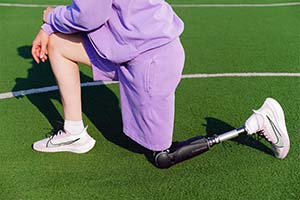
It’s been a whirlwind summer of sports, with the Euros, Wimbledon, and the Olympic Games. After a long and challenging year, people across the country have taken the opportunity to come together and celebrate these athletes’ amazing accomplishments, both in their sporting careers and their personal lives. If you still haven’t had your fill of sport in 2021, the good news is that the Paralympics is underway! To get us into the spirit of the games, Peter Watton from the matched betting experts OddsMonkey is here to tell us more about five inspiring women competing in this years’ games. Kadeena Cox This hard-working Paralympian is going for gold in not just one, but two sports! Kadeena is going to be kept busy in Tokyo by competing in both athletics (in the women’s 400m sprint category) and in track cycling (in the 500m time trials). While she’s now smashing it as a Paralympian, the journey to get to where she is today wasn’t so simple. Kadeena began her career competing in able-bodied events, but was forced to stop in 2014 when she was diagnosed with multiple sclerosis. However, she didn’t let this diagnosis interfere with her sporting career, as she set her sights on attending the Rio Paralympics in 2016. Not only did she get there, but she won a gold, silver, and bronze in athletics, as well as a gold in cycling! But Kadeena isn’t planning on stopping there. She revealed to her 60,000 followers on TikTok that she hopes to one day compete in both the Olympics and Paralympics in cycling. Kadeena also uses herTikTok to debunk disability stereotypes, including the misconception that all disabilities are visible. She’s also spoken out strongly against the racism she’s experienced while competing in the sport, including comments from people telling her to straighten her afro to fit into her cycling helmet. In an area of society that is, in her own words, “dominated by white, middle-class people”, Kadeena Cox is the breath of fresh air needed to diversify the sport and inspire disabled women of colour to follow her lead. Hannah Cockroft MBE Throughout her life, Hannah has been defying the odds. After suffering two cardiac arrests at just two days old, which damaged her brain, nervous system, feet, and legs, Doctors told her parents she would be unlikely to live beyond her teenage years. Not only did she surpass this expectation, but she has become one of the most prominent Paralympians in the country. Hannah’s wheelchair racing career got off to a flying start, and her success only continues to grow. She began wheelchair racing in 2007, and just four years later she won two gold medals in the 2011 IPC World Championships, and a further two golds the following year at the 2012 Paralympics in London. Throughout her career, she’s won an astounding 24 medals, 21 of which being gold. When she’s not competing, Hannah has a passion for charitable causes. In 2019 she was a contestant on the Stand Up to Cancer edition of the Great British Bake Off, and is an ambassador of Forget Me Not Children’s Hospice. She also regularly uses Twitter to encourage aspiring para athletes and speak out against the injustices faced by wheelchair users. Joy Haizelden Joy has been wowing the basketball world from an early age. In fact, she was the youngest member of the squad representing Great Britain in the 2014 Women’s World Wheelchair Basketball Championship, when she was just 15. Since then, she has gone from strength to strength, including being part of the winning team at the Women’s U25 World Champions in 2015, and helping take team GB to a record fourth place finish at Rio in 2016. However, Joy has faced her fair share of obstacles and challenges over the years. She was adopted with her sister at the age of six after being abandoned outside an orphanage in China, and taken back the UK by her adoptive parents. Her spina bifida diagnosis meant she could not participate in PE at school, but this didn’t deter Joy. She kept active, and one day she joined a family friend at their wheelchair basketball group, and the rest was history. As well as being a star in her field, she’s an inspiration off the court. She is an ambassador for Access Your Life, a resource that allows people with disabilities to read trusted reviews on accessible products. Joy also uses her Twitter and Instagram accounts to share her experiences and encourage others to give wheelchair basketball a go. Hollie Arnold MBE You may recognise this Paralympic star from I’m A Celeb. But when she’s not eating creepy crawlies, she’s wowing the world of field athletics. Hollie was the youngest ever athlete to compete in her field at the Paralympics, at just 14 years old, and was the youngest member of the whole team that year. She’s since gone on to break several records and win seven gold medals throughout her javelin career, and is no doubt aiming to add another one to her collection this year. Hollie is also incredibly charitable with her time, as she’s the ambassador of two charities from her home town: St Andrew’s Hospice and Caudwell Children. On top of this, she was the first person with an impairment to appear on I’m A Celeb, and was no doubt an inspiration to disabled fans of the show. Fans keep up to date with her latest news and media appearances on both her Twitter and Instagramaccounts. Kare Adenegan This inspiring young woman began competing in wheelchair racing at the Paralympics when she was just 15. In her first games in Rio 2016, she won an impressive three medals; two bronze and one silver. As well as being a prominent Paralympian, Kare also broke the record set by her idol Hannah Cockroft at the Muller Anniversary Diamond League in 2018, at the age of just 17. On top of this, she won the Young Sports Personality of the
Hannah Stodel: How I Became a Paralympian
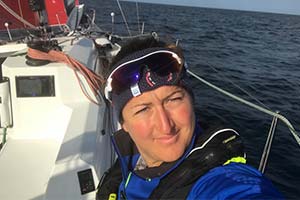
Hannah Stodel the four times Paralympic sailor, and three times World Champion on her successes to date and plans for her next big challenge: entering the legendary Vendee Globe race in 2024… I consider myself very fortunate to have lived by the east coast of the UK throughout my early years and grown so close to the sea. Both of my parents were accomplished sailors and members of Brightlingsea Sailing Club in Essex, where I was born. My mum narrowly missed out on selection to the 1988 Olympic Games in Korea and Dad raced at world level, too. So, my love of sailing was inherited from my parents really – I grew up with them racing so sailing was something of a family hobby, I’ve just always loved it. I was born missing my right lower arm, but from a young age I began competing in mainstream events alongside able-bodied participants. When I was 13 years old, I became the youngest ever winner of the BT YJA Young Sailor of the Year award for my achievements at the Mirror World Championships, which I was hugely proud of. Throughout my teens, I went to Royal Hospital School (www.royalhospitalschool.org) which is located right next to Alton Water Reservoir on the Essex-Suffolk border. The Royal Hospital School Sailing Academy is an established RYA Training Centre and has a fleet of more than 50 dinghies catering for every level of sailing, from beginner boats to Olympic pathway craft. Sailing is a huge part of the co-curricular offering at the school, so it was a dream situation for me because I could do what I loved and keep up with schoolwork at the same time. The school staff were super understanding and supportive of my ambitions to race at a very high level, and the teachers helped me to incorporate taking time off for racing internationally without it affecting my studies. By the age of 15 I was doing well on the able-bodied racing circuit, and I had not actually considered disability sport as an option for me. Then I got invited to train with Andy Cassell, the Atlanta 1996 Paralympic Gold medallist in the Sonar class, for a weekend in Cowes on the Isle of Wight. It was an incredible weekend – a total gamechanger that put me firmly on the path to Paralympic sailing. Fast forward 3 years and I was at my very first Olympic Games, in Athens in 2004. I was just 18 and found it quite overwhelming but an absolutely amazing experience. My nerves were not too bad – I think I didn’t fully take it all in that I was really at the Olympic Games. I’d had a lot of experience at World Championships, which helped to give me confidence. With sailing now dropped from the Paralympics I decided to take on my childhood dream of becoming the first disabled sailor to compete in the Vendée Globe. It is an extraordinary race around the world, solo, non-stop and without assistance. Training-wise, I always do plenty of physical exercise to keep my strength and fitness up, but with this being a solo race, mental strength is also key and is something which was instilled in me at the Royal Hospital School. The more solo sailing I do the more I realise how strong and resilient I am and, surprisingly, how much I enjoy my own company. This type of sailing suits my personality and I love it. There are still moments when I can hardly believe what I’m doing but I thrive off a challenge. It’s a battle to get to the start line thanks to the pandemic. Getting sponsorship is challenging but I’m not going to give up on my dream. I’m going to keep pushing forward and doing my best to make it happen in 2024. My motto is ‘Never give up’.